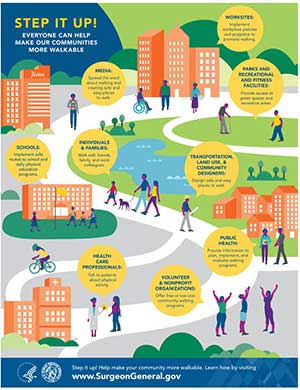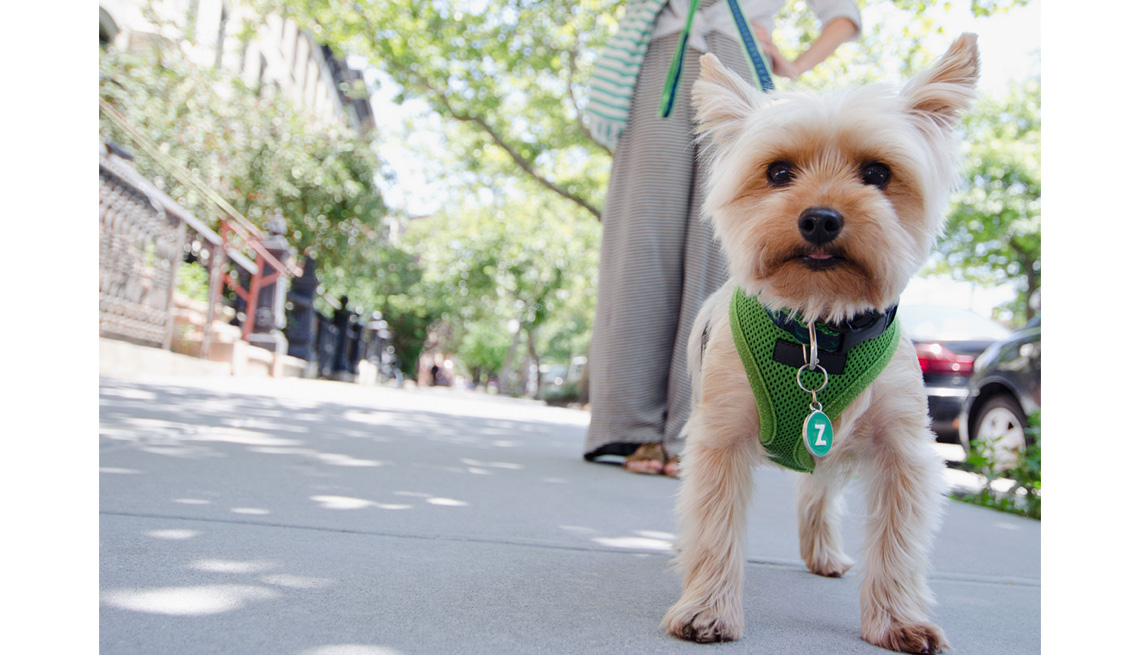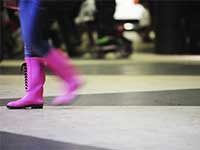Why Walking is Going Places
Here's what's behind the unexpected rise of foot power as a social trend, health breakthrough, path to happiness and overall smart way to get around
Forsaken for decades as being too slow and requiring too much effort, walking is now recognized as a health breakthrough, an economic catalyst and even a route to happiness.
Subscribe Today! AARP Livable Communities eNewsletter
Real Simple magazine declared walking "America's untrendiest trend" in a February 2014 cover story. A month later the construction magazine Builder announced on its cover, "Walkability. Why we care … and why you should too." The reason? Simple: "Increasingly, the market is demanding places where homeowners can hoof it."
The New Yorker weighed in that fall by quoting the book A Philosophy of Walking, which asserts that walking "makes it possible to recover the pure sensation of being, to rediscover the simple joy of existing."
The sheer pleasure of walking was highlighted in one of 2014's top music videos, "Happy," by singer-songwriter Pharrell Williams. It's an exuberant celebration of walking that shows all kinds of people (including basketball star Magic Johnson and comedians Steve Carrell and Jimmy Kimmel) strutting, stepping, striding and sashaying down city streets.

Image from SurgeonGeneral.gov
An infographic from the office of the U.S. Surgeon General explains how "everyone can help make our communities more walkable." Click on the image to see it larger.
Then, very significantly, in September 2015 Vivek H. Murthy, the U.S. Surgeon General, released a Call to Action on the health and social benefits of walking and walkable communities — a step some compare to the 1964 Surgeon General's Report on the dangers of smoking.
"Walking is a simple, effective and affordable way to build physical activity into our lives," Murthy said upon announcing the Call to Action (which was accompanied by its own Pandora playlist). "That is why we need to step it up as a country ensuring that everyone can choose to walk in their own communities."
The U.S. Centers for Disease Control and Prevention (CDC) recommends that all adults engage in 30 minutes of physical activity (such as walking) five days a week based on the proven connection between moderate physical activity and lower incidences of major medical problems — not just heart disease, diabetes and obesity, as you'd expect, but also depression, dementia, anxiety, colon cancer, osteoporosis and other serious conditions.
This flurry of attention about walking is more than a flash-in-the-pan. The evidence that millions of Americans are rediscovering walking for transportation, fitness and fun is as solid as the sidewalk beneath our feet.
Americans are Getting Back on Their Feet
"Walking is the most common form of physical activity across incomes and ages and education levels," explained Thomas Schmid, a CDC health scientist, at the 2014 Pro-Walk | Pro-Bike | Pro-Place Conference. CDC research shows that the number of Americans who go for a walk at least once a week rose from 56 percent in 2005 to 62 percent in 2010. That's nearly 20 million more people on their feet.
The first-ever Walking Summit was held in Washington, D.C., in 2013 and hosted by the Every Body Walk! Collaborative (EBWC), which was founded by the nonprofit health care system Kaiser Permanente. A joint effort of more than 100 influential organizations (including AARP Livable Communities), the EBWC promotes walking as part of the solution to problems ranging from chronic disease and health care costs to climate change and the decline of community. America Walks, a coalition of pedestrian advocacy groups, helps lead EBWC.
The 2013 summit marked the birth of a new walking movement committed to:
- Encouraging everyone to walk more
- Boosting policies, practices and investments that make communities everywhere more walkable.
"In addition to the health benefits of getting regular physical activity, people's health can be correlated to having strong relationships and living in connected communities with high levels of social cohesion," said Kaiser Permanente Vice-President Tyler Norris at the Pro-Walk | Pro-Bike | Pro-Place conference. "Among the important determinants of this sense of belonging is 'Do I know my neighbors?' A walkable community fosters these connections every day by helping us meet people we otherwise wouldn't."
Americans are Living Feet First
Even the American dream is being remodeled to meet the public's growing enthusiasm for walking. According to a 2013 survey by the National Association of Realtors, 60 percent of Americans would prefer to live in a neighborhood that has stores and services within easy walking distance. That's nearly twice the number of people who said they want to live where stores can be reached only by car.
The attraction of walkability is especially strong for the millennial generation, which is entering the workforce and housing market in large numbers.
"With drastically different views of transportation from those of generations that came before them, millennials are transforming communities," notes another report from the National Association of Realtors. "Millennials own fewer cars and drive less than their predecessors. They'd rather walk, bike, car share and use public transportation — and [they] want to live where that's all easy."
Firms in the tech, information and creative industries are at the forefront of the trend toward walkable communities because the coveted young talent they need to stay competitive want to work in places that are a short stroll from cafes and cultural attractions. The first thing Google did after buying the electronics firm Motorola Mobility was to move its headquarters away from the freeways and strip malls of Libertyville, Illinois, to the walkable environs of downtown Chicago.
From his vantage point at the CDC, Thomas Schmid observes, "If a business is located in a community that is not healthy, they're paying more to be there. Think of it as a tax or cost of doing business because of health care costs."
Why Walking? Why Now?
What's driving the growing passion for walking? "It's a convergence of factors," says Christopher Leinberger, a real estate developer, George Washington University business professor and a leading advocate that walkable communities are crucial to our future prosperity.
1. The well-established link between walking and better health, which is reinforced by recent research pointing to the dangers of sitting for long periods. A comprehensive study charting 240,000 Americans between ages 50 and 71 published in the Journal of Clinical Nutrition found that "overall [time] sitting was associated with all-cause mortality."
2. The accelerating costs of owning one, two or more cars, which many Americans, especially younger people, find a poor investment of their resources. Transportation is now the highest cost in family budgets (19 percent), next to housing (32 percent). In auto-dependent communities — where walking is inconvenient and unsafe — transportation costs (at 25 percent) approach housing costs (32 percent).
3. Metropolitan areas with many walkable neighborhoods do better economically than those with just a few. Leinberger's report Foot Traffic Ahead finds that walkable metropolitan areas "have substantially higher GDPs per capita" as well as a higher percentage of college graduates. Office space in walkable locations enjoys a 74 percent per square foot-rent premium over offices in auto-oriented developments in America's 30 largest metropolitan regions.
4. More people are discovering the personal satisfactions of walking. "Seeing friends on the street, walking to work, strolling out for dinner or nightlife," are among the pleasures of walking that enrich our lives, says Leinberger.
Jay Walljasper writes, speaks, edits and consults about creating stronger, more vital communities. He is the author of The Great Neighborhood Book and All That We Share: A Field Guide to the Commons. Visit him at JayWalljasper.com.This article is adapted from one written for the Every Body Walk! Collaborative, of which AARP is a member.
Stay Informed — For Free!
AARP.org/Livable
Enter a topic, name, place, etc.





